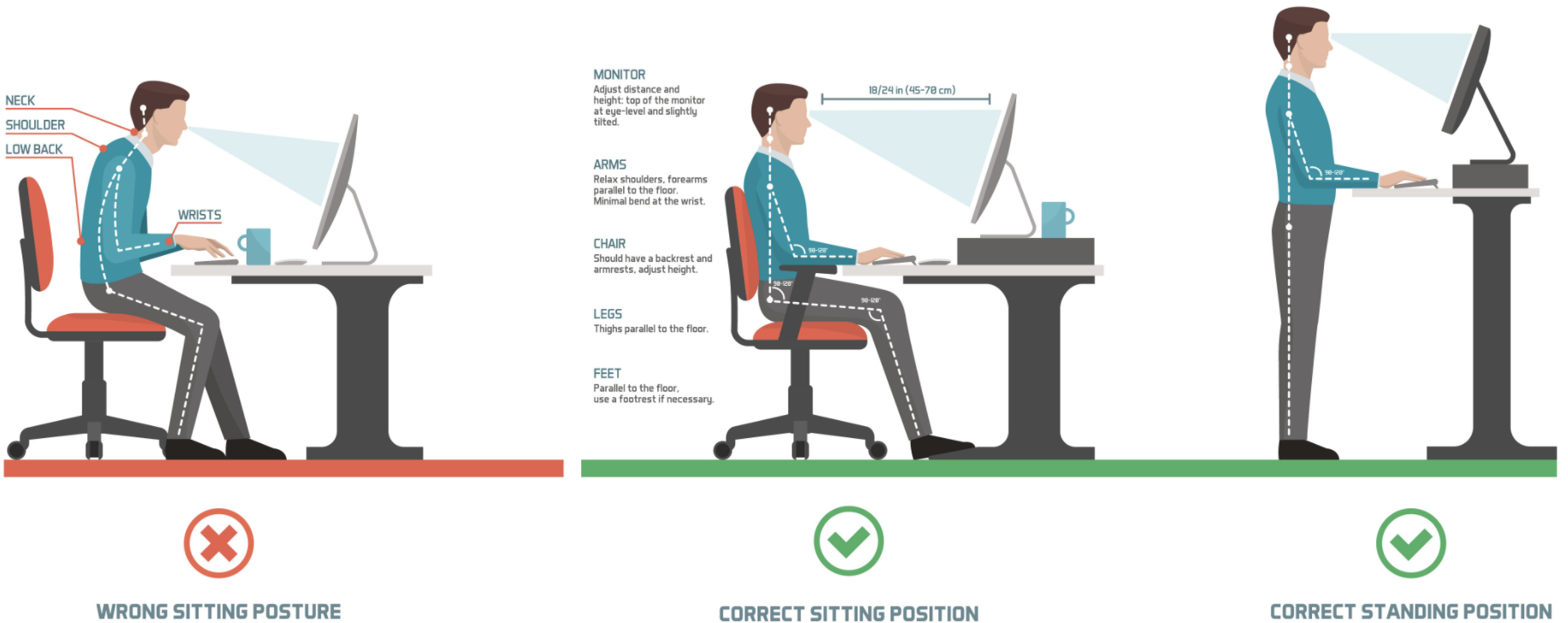To Stand or Not to Stand: How to Improve Ergonomics in the Workplace
Is the way you're sitting holding you back from deep work? If you don’t feel comfortable at your workstation, it can be difficult to focus on the task at hand.
At Firmspace, we understand that ergonomics are personal and that it’s important to find the right tools and adjustments for each professional to support their posture throughout the workday.
In the interest of full disclosure, this article was written at a standing desk, but that doesn’t mean we believe standing at work is a panacea for the aches and pains of office work. Afterall, as Aaron E. Carroll wrote in the New York Times, “They’re not cures for anything, and standing is not exercise.”
Instead, we’d like to offer you five tips to help you find the adjustments you need to improve your posture, comfort, and productivity at work.
1: Check Your Desk Height
The truth behind standing desks is that they are a great tool to have in your ergonomic toolkit, but having an adjustable sit-stand desk is a good option for most people. This is why at all of our Firmspace locations, every proworking space comes with an adjustable standing desk, which can be raised or lowered at the press of a button.
This is great news for those who are moving to a standing desk for the first time: conventional wisdom says to take your transition slow and start adding standing hours into your workday in 30-minute increments. And even longtime upright workers may want to have the option to sit down for a long call or after a long marathon training run before work.
Whether or not you choose to stand, the height of your desk relative to your chair (and the floor), impacts the rest of your posture.
Proper ergonomics support upright posture, sitting or standing at a desk. Source: Health and Balance Osteopathy
An adjustable desk will allow you to ensure that your wrists, elbows, and entire upper body are in line over your keyboard.
2: If You Feel Discomfort, Don’t Wait to Get a New Chair
Think of your office chair the way you think about your mattress: it is a critical piece of furniture that supports your spine through a significant portion of your day. As soon as you feel discomfort in your office chair, make a change.
Maybe that means getting a new office chair altogether or simply supplementing your old chair with the right tool. We’re big fans of the MacKenzie Lumbar Roll, which helps professionals maintain a healthy curve in their lower back and maintain correct posture in the upper spine.
Of course, if you’re not sure where to start making adjustments to your current chair and you’re not ready to commit to a cushion or support, begin by changing the height of the chair and its angle relative to the floor.
Remember that like all furniture, office chairs wear out. Supporting foam elements compress over time. And eventually, it may just be time to get a new executive chair.
3: Improve Your Screentime with a Better Arrangement
Whether you have one screen or several, the most important thing is that it be easily visible to you.
If this sounds obvious, consider whether there are currently conflicting lights in your office environment or if the glare of the sun impacts your view of the screen at different times of day. You may quickly find room to improve the position of your screen(s) or light fixtures.
In addition to location, there’s also the matter of brightness. While the myth of the dangers of blue light from our screen has largely been debunked, it still matters a great deal how bright your screen is, how far it is from your eyes, and how much you have to squint or strain on a regular basis.
If you’ve been experiencing eye fatigue, even after moving your screen farther away from your face, try turning down the blue light and brightness of your display to improve your ergonomics in the workplace.
4: Boost Your Energy and Mood with Natural Light
If you’ve ever walked into a windowless office to start your day, you know just how rough that outdoor-indoor transition can feel.
We design all our Firmspace offices to maximize natural light because we believe that it matters. Part of developing positive work hygiene is to establish a regular cycle of daily activities, and syncing this up with the rising and setting sun can help you manage your energy and your focus.
So, open the shades. Take advantage of the natural light at your disposal, and if it’s limited within your office, make a point to go outside during the day.
5: Consider the Benefits of Active Work
Have you ever tried using an under-desk treadmill or an elliptical? If so, you know just how peaceful and meditative it can be to get into a groove. In our experience, these tools can provide more of a distraction than not, but if this is part of how you work best, that’s fantastic.
But you don’t have to buy a stationary recumbent bike to introduce activity into your workday. If you’re struggling with workplace ergonomics and your health, our best recommendation is not related to equipment at all: make activity part of your workday. Make a point of taking a break from your desk – whether you’re seated or standing – and get moving.
As any fan of pedometers knows, just a few hundred steps an hour can make a huge difference over the course of a day. Taking a break also gives you a chance to shake out any tired muscles and reset your posture when you return to your station.
Your Proworking Space Should Work for You
Too often, when the word “ergonomics” comes up, people think of uncomfortable kneeling chairs or standing all day on aching feet. But having a workplace with proper ergonomics is all about comfort and wellbeing. It’s about ensuring that the tools you have at your disposal facilitate a productive and healthy experience.
Your office is where you go to get work done. It’s a sanctuary from the many distractions at home and in the world at large.
At Firmspace, we provide flexible, ergonomic furniture in our private offices so that members can feel their best while they work. If you’d like to see how this set-up might work for you, sign up to take a tour today.


